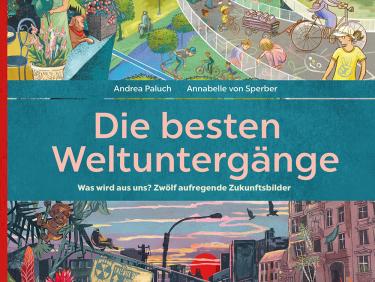Book Review: The best ends of the world
Talking with children about the (post-)apocalypse? Now there is a book for that. And although the title somewhat misleadingly reads “The best ends of the world”, the book includes dystopian as well as utopian scenarios: from a global flood to a sustainable eco-future or a world with only children in it. However, since I am not the target audience of the book, I was pleased to be able to have Florian (8 years) critically review the book and give me his opinion.

Philipp: Let’s have a look at the first one: people are forced to live in large glass domes due to the bad air quality outside.
Florian: Well, I think the problem is that they will run out of oxygen. Ok, in the larger ones there are plants, but still...
And what do you think about the assumption in general – that air pollution is becoming so bad that people can no longer breathe it?
It does not surprise me; it is almost somewhat normal for me. I have thought about something like this already.
And what about this: humanity living in a spaceship, after planet earth is destroyed?
Well, it certainly is nice to sit in a spaceship. But my criticism is, that not all humans would fit into that spaceship. Many would have to die; and surely that is bad.
There are also some concerning scenarios in the book. What did you think about them? For example the next one.
Ah, the age of drought. This is governed by the law of the strongest, which I do not find very good. This has happened in war times, but I do not believe that anybody wants to experience that again. There you also see refugees, who want to traverse the country.
They want to access the water sources?
Yes, they try to. But there are soldiers who are pushing them from the ladder at the fence. This makes me think of the people in Africa who need to flee. I think it is really horrible when you have to live through something like that, a horrible scenario.
Which, you could say, is very much like the next one, which is also a quite dark and scary vision.
Yes, this is the virus pandemic. But for me, this is actually rather normal, daily life I would say. Because all the people are currently wearing masks and need to keep 1,5 meters distance. As is happening in the current COVID pandemic.
But it could become much worse?
Yes, but also in Germany it can get worse currently with the Delta variant. For example, my cousin got Corona.
Oh, I am sorry to hear that. Is she ok?
Yes, she is doing well. But many others have serious health problems. And not only in the Corona pandemic, also cancer for example. This is also a huge problem. By the way, also my mice had cancer unfortunately.
Oh, I am also sorry to hear that. There are many terrible things happening. Coming back to the book, which story did you find the most threatening?
I think this is the worst scenario: when sun rays become deadly. The ozone layer of the earth is destroyed in that scenario. But this already has happened once, I think it is unrealistically that it will happen again.
Yes indeed, several decades ago, gas from spray cans and old fridges was destroying the ozone layer. But the governments around the world recognized, that this is a big problem. They got together and banned theses gases. When you say, you think it will not happen again, do you think they will be able to do this again?
Yes, I think so.

But if we are looking at climate change, the governments do not seem to be able to come up with agreements.
Oh right, that is true. I think just recently all the ministers for the economy met, and what did they agree on? Nothing…
But still, do you think it is a good idea to make a children’s book on the end of the world and the future, what can happen for good or for bad?
Yes, I enjoyed it!
Thank you very much for your feedback on the book.
What can be concluded? The book is an invitation to discuss and think about the present as well as possible futures. And indeed, looking beyond the provocative title of the book, the backside is much more specific: “The world as we know it, will go down. But what comes after? We have a say in that.” Maybe the book by Andrea Paluch and Annabelle von Sperber comes at the right time, as youth and children are well aware of the global threats through the pandemic they live in or climate change with increasingly visibly consequences. Having a set of utopian but also dystopian nice to look at scenarios can be a good starting point for a conversation.